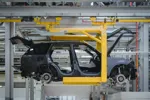A healthy new car market should translate to healthy levels of leads, but dealers must use targeted and swift communication to beat rival retailers to the punch if they want to convert sales.
Whether chasing a private individual or an SME looking for company vehicles, the battleground is no longer about lead generation, but more about how quickly and professionally leads can be managed.
A rapid, well informed response is critical, and increasingly has become a part of the manufacturers’ franchise standards. With the sale and quality bonus riding on the response, this means many automotive managers are monitoring lead responses very closely.
Anna Ling, Swansway Group marketing director, said monitoring how quickly sales executives are following up on leads is important.
“This digital age has meant that prospects and customers alike want to be contacted within minutes rather than hours. It’s essential that this happens,” she said.
“We use a central system to track enquiry response times by site and sales exec. The same system is used to monitor the quality of responses and then to highlight any staff training that might be required.”
Swansway has a renewals and retailer support centre at its head office and all new sales executives visit the department when they join. However, Ling said all sales executives are also encouraged to take the time to prospect for new customers individually.
“We do have the capacity to prospect with the contact centre, but we find that allowing sales execs to prospect and thus to be the original point of contact, allows them to build a relationship with their prospective customer,” she said.
Cambria Automobiles invested in rapid response software to help its sales executives. This links leads to employees’ smartphones and most get a response within 60 seconds, said Ian Godbold, its marketing and CRM director.
Godbold said once initial contact is established, Cambria’s customer relationship programme makes contact again, after 24 hours, 72 hours and 14 days, with relevant and helpful information.
“If you’re the business supplying them with all the information they need, they’re going to come to you for the sale,” he said.
“If you’re not responding quickly enough, you can lose that customer because the chances are they are at the buying stage and they may have contacted three or four other dealerships.
“They’re testing you to see how quickly and professionally you can deal with their request and that is usually the difference between converting or not.”
Cambria checks on how its associates are following up on leads with a dedicated web specialist on staff at each dealership monitoring all leads going into the business.
Each day at 5pm they check whether sales lead details have been put in the customer relationship management system, whether they have been followed up and checking what the next action needs to be and who should take it.
Missed leads are reported to the sales manager or general manager.
Godbold said: “Clearly it’s in the best interests of the associates to follow up on these leads, but this extra process makes sure we’re filling any holes that might be in the bucket.”
A proper follow-up and monitoring process is vital, because customers are transient, according to Karen Hilton, Carwow head of sales operations and B2B communications.
“Dealers and manufacturers are often surprised to learn how transient customers are. Most customers on Carwow will configure up to three different makes of vehicle.
“Therefore, if the quickest brand to get back to them wasn’t perhaps their favourite at the outset then it can quickly win favour through great customer service and lead-handling.”
Dealer staff also need to recognise that a lead requires handling differently depending on what stage a prospect is at in their buying journey. And it’s not all about booking that face-to-face appointment in the diary.
Jeremy Evans, Marketing Delivery managing director, said: “If a customer is seven days into their buying journey, a contact to ask how their search is going and offering help could be useful. 14 days, 21 days are they still looking? Is there a reason you haven’t bought from us?
“The more personalised you can make these communications, the better success you’re going to have on open and click-through rates.”
Hilton said messaging with any contact needs to be timely and relevant for the customer you’re trying to convert.
She said: “For many dealers, the challenge will be lacking the sophistication and know how to send targeted communications by audience type.”
Hilton said dealers investing in electronic direct marketing need to be sure there is a clear call to action, but even if that is present in communications, they should also be prepared for low open and click-through rates due to hitting a “cold” audience.
First contact
Evans said: “The best solution will always be to contact the customer in the way they have asked. If they don’t want to be contacted on the phone because they’re at work it can be extremely annoying if a dealer hasn’t registered that and calls.
“If a potential customer emails back and asks for a call, then do that. It’s just common sense, but these are things that can slip.”
Evans doesn’t think a dealer’s approach should change drastically between approaching a retail customer or a fleet customer.
“They are both still people and both will use the same methods to research vehicles to find what they are looking for,” he said.
“They will interact through social media, emails and search the web, just like a retail customer. Small business owners are still checking their Facebook accounts every day.”
Business communication needs to take into account the size of the business targeted and the scale, as larger companies will be looking for packages encompassing leasing/servicing and maintenance with a single point of contact for invoicing.
Dealers targeting fleets should look at communications about what is going to be more beneficial to a company’s bottom line and explain how the dealership can help on areas such as cost control.
Hilton said: “Brands should be reflecting the key concern of the audience in their communications, yet many dealers still struggle to get traction when communicating something like the whole life costs of vehicles to a fleet customer.”
She said many dealers and manufacturers often track, trace and record communications for training, but many lack the time to actually conduct that training, therefore the recordings become a “get out of jail free card” when a customer complains.
“Salespeople need to be given clear guidance on the process they should be following but enough room to express their flair and personality.”
Ling said: “Our website and social media generate an awful lot of leads for us, but grading them from hot to cold is not an exact science.
“A prospect requesting a test drive might be seen to be a hot lead while a prospect viewing a used car on our site and then valuing their own vehicle via our online valuation tool, is not so hot. But the fact is that consumers browse and shop in different ways and when they end up making an enquiry it can be in many different formats.”
One way to help give conquests a little push is to offer an incentive.
Ling said: “We’re always looking for innovative ways to introduce new customers to Swansway and we’ve recently been offering hotel stays and spa breaks as a test drive incentive, something which we’ve seen in used in other retail sectors.”
















Login to comment
Comments
No comments have been made yet.